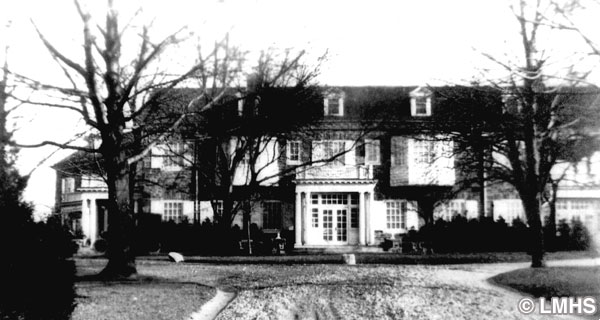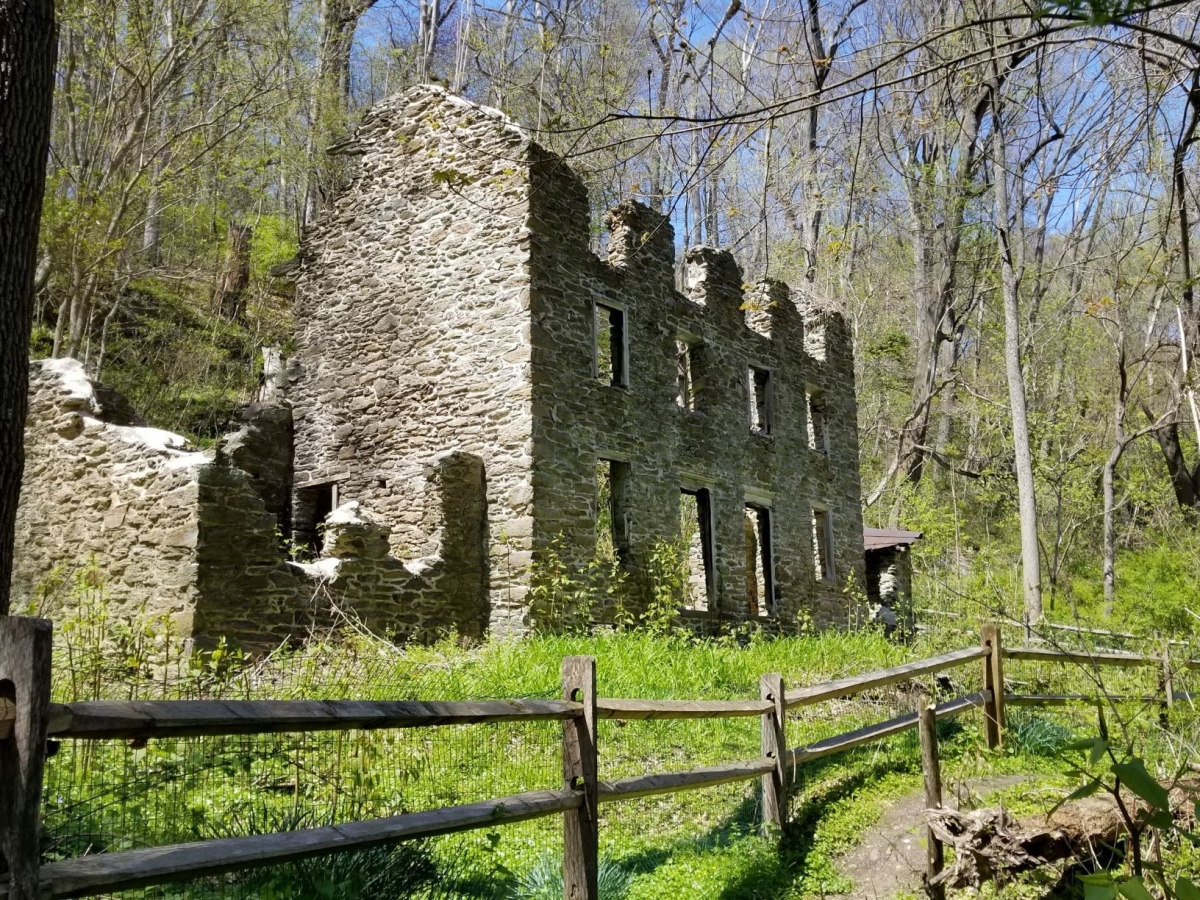Related Posts
- Buy Tickets for The Constitutional Walking Tour of Philadelphia – See 20+ Sites on a Primary Overview of Independence Park, including the Liberty Bell and Independence Hall
- Valley Forge National Historical Park
- Schuylkill River Trail & Schuylkill Banks
- U.S. Census - Tracing its Roots Back to Independence Hall in 1787
- Welcome Park - William Penn
Overview
Rolling Hill Park is a large 103 acre public nature park located in Gladwyne, Pennsylvania, just about 10 miles from Center City Philadelphia. You can step back in time and enjoy the 90 acres of woodlands, meadows, and streams. Hiking, dog walking, playing in and around the creek, fishing, horseback riding, and picnicking are welcome. It is mini oasis with great trails and terrain.

In 2014, Philadelphia Magazine awarded Rolling Hill Park with a Best of Philly award - "2014 Suburban Dog Park".
Features
Natural features include Mill Creek and its valley, mature woodlands occupying the steeply sloped stream valleys, and the meadows of the ridge top.
Important cultural resources include the footprints of the Walter Pew estate house, the silo and barn of the former farm, and the ruins of mill workers' housing along the idyllic Mill Creek.

Trails
The trail system has been designed for a variety of experiences. Below is a description of the official trails as originally planned:
- The Creek Trail (blue) leads down to Mill Creek where the ruins of millworkers' housing can be viewed. The trail traverses steep slopes in excess of 25% grade in parts.
- The Estate and Farm Trail (orange) on the ridgetop affords easy views of the former estate and farming operations.
- The Meadow Trail (yellow) provides views of the grass and wildflower meadow.
- The Woodland Trail (green) highlights the contrast between older, established woodlands on the valley slopes and the younger, developing woodlands on the former pastures.

Please note that there are several other unofficial trails that all seemingly lead down to Mill Creek and provide creek access. Some trails are quite steep, and in some places, there have been steps installed to help safely navigate Rolling Hill Park. Please stay on marked trails. In the woodlands, the delicate herbaceous layer is easily trampled, so straying off trails in steep areas causes erosion.

Restroom Facilities
Bathrooms are located in the former bathhouses for the Pew estate, and they are handicapped accessible.
The History of the Estate
- 1880s: From Working Farm to Gentleman Farm - In the 1880s, farming became increasingly unprofitable in suburban Philadelphia. The Philadelphia and Reading Railroad stopped at Rose Glen in Gladwyne which made the commute from the Main Line to Center City Philadelphia very easy. Land values in the Main Line rose quickly. Area farms changed from "working farms" to "gentleman's farms" where the main means of income was from a source other than farming. After having visited Megargee's Folly Farm, as this property was then known, the Reverend S.F. Hotchkin described this change in rural Pennsylvania in and around the Philadelphia area.
“Folly Farm is so styled because it’s owner, Irwin N. Megargee, in conducting a model dairy farm and stock farm, found the work unprofitable. The place is located in Lower Merion Township, the farm comprising forty-five acres. Mr. Megargee purchased the place from John Baltz, in AD 1892, it being the old family homestead, and remodeled the antique stone house, preserving the Colonial Style. An artesian well gives an ample supply of water. The house is on a high location, overlooking all of the surrounding country, including Roxborough, and at night, the electric lights on the towers of Girard College are visible. The environs are simple and rustic, but the mansion bursts upon the view a little while before reaching it. The two driveways run through high hills and wooded land, and the proprietor has macadamized about a mile of the road on his own place.”
- 1905: From Country Home to Permanent Residence - Irwin Megargee died in 1905. His family moved permanently to Gladwyne because real estate value there were rising, and it was considered more profitable to hold suburban property. The Megargee family enlarged the house slightly and changed the name from Folly Farms to Pen-y-Bryn, meaning the top of the hill.

In 1909, the estate was sold to C. Paul Hegenlocher, an investor, who with his wife, Dora, lived there for 20 years. They demolished the house and built a much larger Colonial Revival one. They also added buildings to the farm complex: a chicken coop, a round concrete silo, and a rectangular chicken coop. The remains of these three buildings can be seen on the ridgetop today at Rolling Hill Park.

- 1929: From Residence to Estate - Walter Pew, grandson of the founder of Sun Oil, bought the 43-acre parcel in 1929, shortly after the stock market crash and the Great Depression. Pew renamed it Rolling Hill Farm, but he focused less on agriculture and instead expanded his land holdings to create a significant suburban estate. In 1933, Pew purchased 60 additional acres which included the steeply wooded slopes of Mill Creek Valley.
Today, those are some of the most popular wooded areas and trails for visitors and their dogs to hike in order to reach the creek. West of the house, Mr. Pew added the swimming pool and bathhouses that remain today (today the bath houses serve as restrooms), and a tennis court. The Pews and their two children lived at Rolling Hill until 1948. Unfortunately, the house was largely unoccupied from that time until it was destroyed by fire in 1958 that started from a blow torch accident that occurred while the house was being dismantled.
Mill Creek: The Power of Water
Mill Creek gets its name from the active mill industry that flourished here from the 1790s to the 1870s. The mills adapted to suit a changing market place. During the early 1800s, a growing mill industry produced paper, grain, gins, and gunpowder. In the 1850s, cotton yarn became the predominant product. The mill industry declined during the 1890s. Large automated factories were built along railroad lines and the smaller scale mills could no loner compete. In 1893, Mill Creek had a disastrous flood, and the dams along Mill Creek were destroyed and never rebuilt.
The Barker Mill Dates Back to William Penn
The existing industrial buildings along Mill Creek adjacent to the park boundaries are known as the Barker Mill. It is the longest-lived mill on the creek. The parcel of land on which it is located was part of the original patent granted by William Penn to Robert Jones to establish the Welsh Barony in 1682. It is believed that Benjamin Brooke built the first mill around 1794 either to produce gunpowder or manufacture armaments.
From 1808 to 1861, the Nippes family operated a mill to manufacture rifles. During the War of 1812, they supplied rifles to the United States Government. In 1881, the mill was sold to William Booth. The cornerstone on the existing building reads “WM BOOTH ROSEGLEN MILL 1886.” It produced carpet and rug yarn. The name Barker comes from Thomas A. Barker who bought the mill in 1923. He and his sons carded and spun wool there until the 1950s. In the 1970s, the building was renovated for more modern uses: light industrial, offices, and artisan studio space. Today, that building remains, but it is abandoned.
The Ruins

Visible along the floodplain of Mill Creek are large stone ruins that once housed mill workers. The mills themselves generally employed about 6-10 workers. The U.S. Census of 1850 indicates predominant populations of laborers, mill workers, and local craftsmen in the Mill Creek area. Workers were housed on the property in tenements that could accommodate several families. There are two sets of major ruins along the floodplain of the park.
Samuel Lehman Smith, a mill owner, constructed it between 1837 and 1840. Nearby is a root cellar. The other ruins, downstream closer to the Barker Mill, consisted of two buildings. One was a single unit that housed one family or several workers. The other was a double unit that housed two families. Both contained stonework, heavy fireplace lintels, and attached kitchens. They date from the first quarter of the 19th Century.
The stone ruins are being stabilized through the efforts of the Lower Merion Township’s Board of Commissioners.
Education
Rolling Hill Park is used as an outdoor classroom to teach about the history of early Quaker settlement and industry in suburban Philadelphia, specifically in Lower Merion Township.
Safety and Precautions
Deer ticks are found on the tall grasses in the meadows as well as in the woodlands. Deer ticks can transmit Lyme disease. You may want to bring bug spray. Please stay on the mowed trails in the meadows.
For your own safety and for the protection of the site’s cultural resources, please do not climb on any of the ruins and please do not take artifacts.

Funding
This project was financed in part by a Keystone Recreation, Park and Conservation Fund Program grant from the Pennsylvania Department of Conservation and Natural Resource, Bureau of Recreation and Conservation.
Rolling Hill Park
1301 Rose Glen Road
Gladwyne, PA 19035




